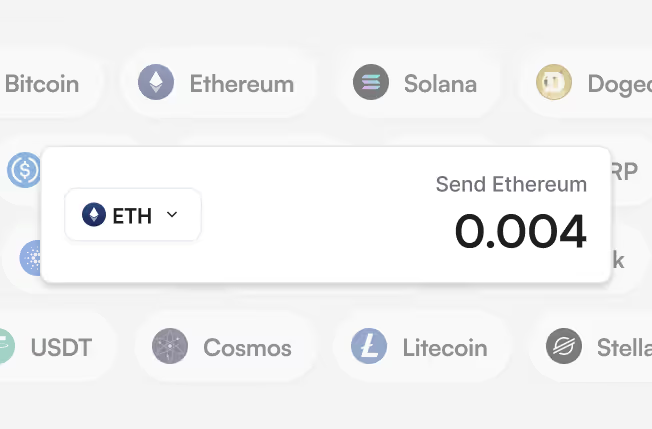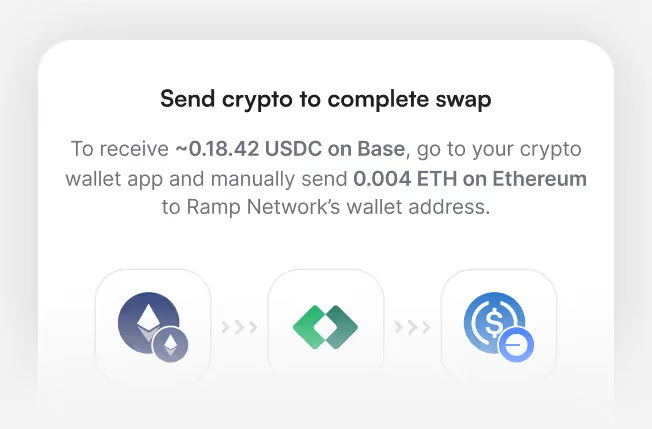


Swap Ethereum to Solana instantly.
Convert Ethereum (ETH) to Solana (SOL) quickly and securely – no complex bridges or decentralized exchanges required.


.svg)










Convert Ethereum (ETH) to Solana (SOL) quickly and securely – no complex bridges or decentralized exchanges required.


.svg)







Exchanging Ethereum (ETH) for Solana (SOL) doesn’t need to be complicated. With Ramp Network, the process is designed to be clear and secure.

1
Choose Ethereum (ETH) and Solana (SOL), enter the amount you’d like to swap, and review the live exchange rate.

2
Sign up with your preferred method and confirm your country of residence.

3
Ramp Network works with both self-custodial wallets such as MetaMask or Ledger and custodial exchange accounts.

4
Transfer the ETH from your wallet. Once the transaction is confirmed on the network, SOL is delivered directly to your selected wallet or exchange account.

Ramp Network lets you connect both self-custodial wallets such as MetaMask or Ledger and custodial exchange accounts. When swapping ETH to SOL, you simply choose your wallets and confirm the trade.






The process is designed to be clear and straightforward. Ramp Network avoids unnecessary blockchain jargon so anyone can complete an ETH to SOL swap with confidence.
You stay in control at all times. ETH is sent directly from your wallet, and SOL is delivered to the destination wallet you specify.
Ramp Network supports users in major regions including the UK, EU, and US. Service availability depends on your location and is displayed during checkout.

Before you confirm, all costs and exchange information are shown upfront, so you know exactly how much SOL you’ll receive.
*When compared to transferring via an exchange

Ethereum isn’t just another cryptocurrency, it’s where a lot of what we now call Web3 really started. Back in 2015, a group of developers led by Vitalik Buterin tried something different: a blockchain that could actually run code, not just move money around. It sounded ambitious, but it worked.
Every time someone interacts with a decentralized app, mints an NFT, or locks coins in a DeFi protocol, there’s Ether (ETH) behind the scenes making it all happen. People use it to pay gas fees and to keep the network secure. Ethereum later switched to Proof-of-Stake, which made it far more energy-friendly, something even its critics now admit was overdue.
Today, Ethereum quietly powers thousands of apps, games, and financial tools that most users don’t even realize are on-chain.
Bitcoin (BTC) is the world’s first cryptocurrency, launched in 2009 by the mysterious creator known as Satoshi Nakamoto. Built on blockchain technology, Bitcoin introduced a new way of transferring value online without the need for banks or intermediaries. Its decentralized nature, combined with a fixed supply of 21 million coins, makes it a unique digital asset often referred to as “digital gold.”
Today, Bitcoin is the most recognized and widely used cryptocurrency worldwide. Millions of people use it for trading, investing, and cross-border payments, while businesses across industries accept Bitcoin payments as a secure and transparent alternative to traditional money. Its popularity continues to grow, supported by increasing adoption from financial institutions, mainstream investors, and even governments exploring Bitcoin regulation.
What makes Bitcoin special is its combination of scarcity, security, and decentralization. Unlike fiat currencies that can be printed endlessly, Bitcoin’s supply is limited, creating long-term value potential. Its blockchain is maintained by thousands of nodes across the globe, ensuring transactions remain transparent and resistant to censorship. For many users, Bitcoin represents more than just an investment — it’s a revolutionary step toward financial freedom and the future of money.
The chart displays an indicative, mid-market exchange rate. Effective exchange rate might be different.

If Ethereum is the old guard of smart contracts, Solana is the fast-moving newcomer that refuses to slow down. It was launched in 2020 by Anatoly Yakovenko, an engineer obsessed with speed and scalability, and he more or less delivered.
Transactions on Solana take seconds and cost fractions of a cent. For developers building NFT projects, DeFi tools, or on-chain games, that’s a huge deal. The SOL token keeps everything running, it’s used for staking, paying transaction fees, and participating in governance.
People sometimes joke that Solana feels like “crypto with a turbo button.” It’s not perfect – no blockchain is, but it’s fast, cheap, and keeps pushing boundaries in ways that make it hard to ignore.
Bitcoin (BTC) is the world’s first cryptocurrency, launched in 2009 by the mysterious creator known as Satoshi Nakamoto. Built on blockchain technology, Bitcoin introduced a new way of transferring value online without the need for banks or intermediaries. Its decentralized nature, combined with a fixed supply of 21 million coins, makes it a unique digital asset often referred to as “digital gold.”
Today, Bitcoin is the most recognized and widely used cryptocurrency worldwide. Millions of people use it for trading, investing, and cross-border payments, while businesses across industries accept Bitcoin payments as a secure and transparent alternative to traditional money. Its popularity continues to grow, supported by increasing adoption from financial institutions, mainstream investors, and even governments exploring Bitcoin regulation.
What makes Bitcoin special is its combination of scarcity, security, and decentralization. Unlike fiat currencies that can be printed endlessly, Bitcoin’s supply is limited, creating long-term value potential. Its blockchain is maintained by thousands of nodes across the globe, ensuring transactions remain transparent and resistant to censorship. For many users, Bitcoin represents more than just an investment — it’s a revolutionary step toward financial freedom and the future of money.
The chart displays an indicative, mid-market exchange rate. Effective exchange rate might be different.
Customers like you have traded over $1 billion in crypto with Ramp Network.